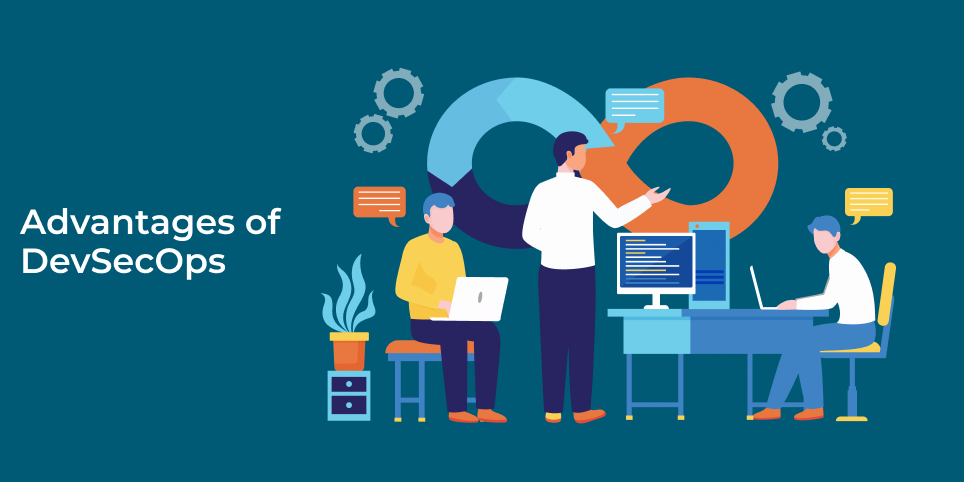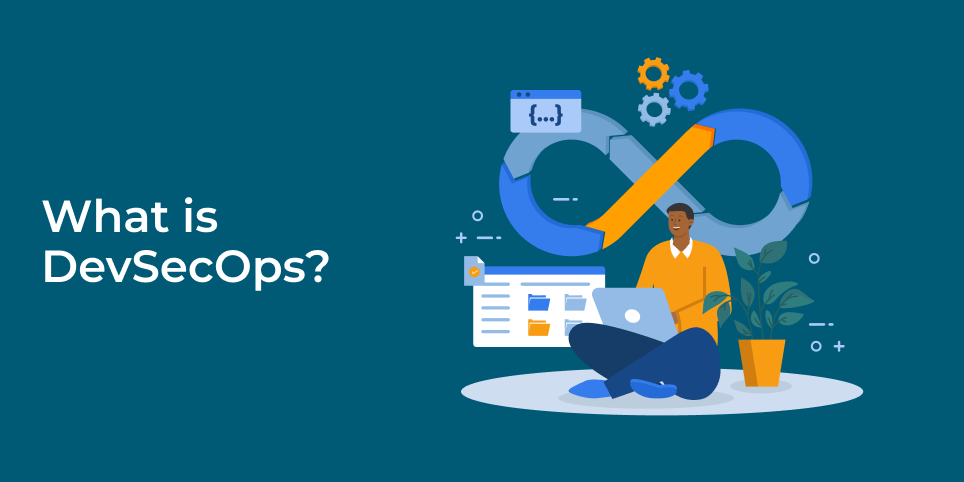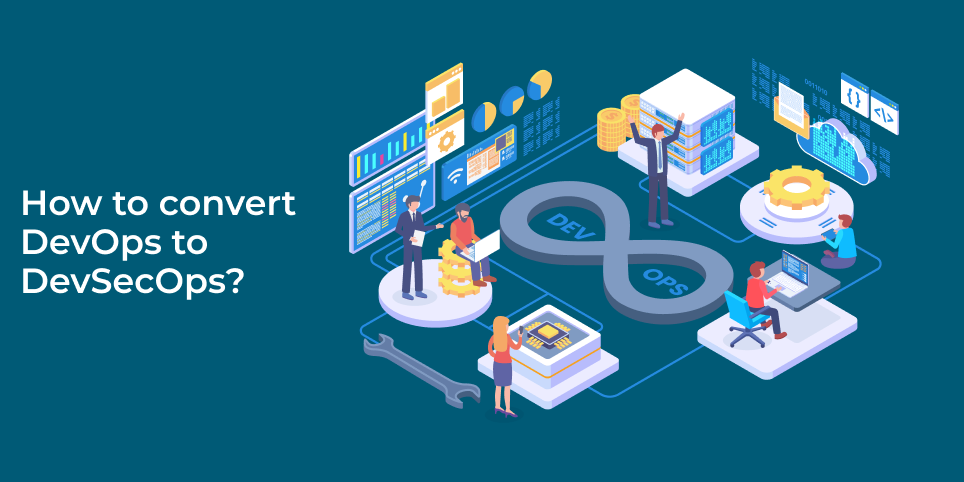
A Short Guide to the Primary Differences Between DevOps and DevSecOps?
Table of Contents
The software development environment is continuously on the cutting edge of innovation. The ongoing deployment of disruptive technologies and the demand for change have led to a massive software development revolution. As a result, several software development professionals, if not most, have embraced the agile technique. As a result, the focus of the training has shifted from process improvement to skill prioritization, leading to advanced development approaches like DevOps, SecOps, and DevSecOps.
What is DevOps?
Two aspects of computer science are combined in the DevOps approach. Software development is referred to by the acronym “Dev,” whereas information technology services are referred to by the abbreviation “Ops.” Globally, the DevOps market reached USD 4,311.95 million in 2020. This is expected to surge at 18.95% CAGR with a projected market value of up to USD 12,215.54 million by 2026.
DevOps aims to accelerate the performance of the software by enabling working cohesively, intelligence, automation, and combination. Developers gain control over the product architecture thanks to the necessity of DevOps across the development process, allowing them to give software performance priority above all other considerations.
What is DevSecOps?
The DevSecOps mixes DevOps with SecOps, forming a cyclical system for software development, technology operations, and cybersecurity.
The main goal of DevSecOps is to facilitate the rapid creation of a secure codebase. The DevSecOps technique encourages developers to have a viewpoint rather than prioritizing development activities or security. A flexible framework allows the development and security teams to provide ongoing assistance.
Advantages of using DevOps
- Make the work environment stable- Debugging, adding new features, or modifying the existing code can occasionally make developers unhappy, which harms their ability to work efficiently. The process is streamlined, and your workload is somewhat reduced when you use DevOps principles.
- Bringing innovation to the ideas- DevOps approach encourages all kinds of automation, which provides a way for automating any repetitive operations. Traditional DevOps enables us to concentrate on essential things and demand effort.
- Brings agility in business- Agility in your company can undoubtedly help you maintain dominance. DevOps deserves all the credit since it can provide the scalability required to alter the organization.
- Reasonable cost of production- If your company is agile, it will help you maintain dominance. DevOps is quite important as it helps provide scalability and will help you alter your organization.
- Continuous delivery of software- The primary goal of the DevOps approach is to make all departments equally responsible for upholding stability and providing improved features. Because of this, the software is sent very quickly and smoothly compared to other types of delivery.
- High-Quality Results- Better outcomes and high-quality products are produced when development and operations teams work harmoniously. Regularly considering user feedback increases the value of the company.
Advantages of DevSecOps

- DevSecOps incorporates a solid strategy to reduce cybersecurity risks and threats right from the start of the development cycle. This implies that development teams will rely on automated security solutions to test code immediately after security audits without delaying development. The DevOps team’s primary responsibility will be debugging, testing, scanning, auditing, and reviewing.
- By automating the process and empowering compliance teams to ensure that the security policies support rapid development cycles, DevSecOps has emerged to integrate security right from the start of the development cycle.
- The main goal of DevSecOps is to bring together and encourage early collaboration between the application and security teams. The guiding concepts of DevOps and DevSecOps are categorically opposed to dissimilar operations; instead, they adhere to a collaborative teamwork strategy that guarantees better and more efficient results and a quick procedure.
- The main benefit of DevSecOps is automation; you may use automation from the point at which security vulnerabilities are discovered until a remedy is obtained. Prebuilt scanning tools can check any prebuilt container images in the build pipeline for CVEs. DevSecOps additionally assists you in keeping an eye on security precautions that not only reduce security risks but also provide insights to teams so that they can quickly collaborate when vulnerabilities are discovered.
What is SecOps

SecOps is a part of DevOps and DevSecOps, and is the merger of two different concepts. Sec identifies as cybersecurity and Ops is operations.
Key Goals and Responsibilities of SecOps

Goals
- Keeping the priority of cybersecurity concerns stagewise during the development process
- To consider the security dynamics for improvement and to get adapted to the changes
- Responsibility allocation with regards to security to all those are involved in the team
Responsibilities
Incident Response
- The SecOps team is responsible for managing and implementing the incident response plan. It does not matter if any unauthorized and unexpected event arises
- All sorts of unexpected vulnerability about security or any other risk factor is addressed by arresting it before the end-user comes in contact.
- After identifying any unauthorized access or finding someone breaching the code, the incident response alerts the team soon to prevent the cyber attacker to fetch any information
Root cause analysis
- With Secops analysis, the team can dive deeper than the word depth
- They can trace the unauthorized issue or a sudden risk factor that can disturb the security of the app.
- They also help to intimate the team and give an alert for taking necessary steps.
Threat intelligence
- This is a two-step security procedure having the ability to fetch the knowledge and learn about the potential security risks that may come to the company.
- In response, it also aims to develop strategies that can recognize security threats and respond accordingly.
DevSecOps vs. DevOps
It’s simple to assume from the terms that DevSecOps is merely DevOps with security added; however, this isn’t the case.
The development and operations team collaboration, known as DevOps, is the only aspect of the development process that it concentrates on. Here, these two teams jointly create procedures, KPIs, and milestones to target. By doing this, the operations team can better examine the delivery stages while considering ongoing changes and comments from the development team.
Similarities between DevOps and DevSecOps

Here we have listed a few of the similarities between DevOps and DevSecOps, which are essential and coders should always keep in mind.
Collaborative Culture
The significant difference between DevSecOps and DevOps and conventional techniques is the collaborative environment. The main objective of both is to speed up the development process while saving time and money. DevSecOps and DevOps categorically oppose discrete workplace cultures. In addition, DevOps and DevSecOps aid teams achieve development goals like faster deployment and iteration while minimizing risk and interfering with the app’s security.
Infrastructure as Code (IAC)
You can design and implement the infrastructure you need using code thanks to a technology called infrastructure as code. This technique does not require an IT specialist to carry out labor-intensive manual operations like managing operating systems, installing software, configuring servers, and other such duties.
Active monitoring
Both the DevOps and DevSecOps paradigms encourage active data monitoring to foster learning and simple adaptation. It is an excellent habit to consistently monitor and analyze the app’s data to develop more robust and more data-driven software in the future. Additionally, the team can improve current security procedures and repair application vulnerabilities more quickly thanks to real-time monitoring and data analysis to enhance application performance.
Automation
Apart from cooperative effort, the term automation distinguishes the concepts of DevOps and DevSecOps. When it comes to DevOps and DevSecOps, automation is quite essential because it handles the elimination and management of routine, repetitive chores without requiring the intervention of an IT specialist.
Microservices
If we were to put it simply, microservices are the little components of an application that are put together to form a whole system. By dividing complex code into manageable chunks using a microservice architecture, developers can simplify and ease the burden of their work.
Faster iteration and quicker release
We have already covered numerous times how shared responsibility is encouraged by DevOps and DevSecOps. Since the teams are cooperating and responsible for producing the most significant outcomes in each area, the time will be shortened relatively short.
How to convert DevOps to DevSecOps?

Given how much SecOps and DevSecOps have inspired us, let’s discover how to transform DevOps into DevSecOps:
Prepare a Team
To ensure no future obstacles, you should establish a dedicated team for DevSecOps before beginning the conversion process from DevOps to DevSecOps. It would help if you educated your team members on putting security first and applying security measures right from the start of the development process.
Shift Security Left
Before the application is set to launch, the security procedures will be integrated, or development will take a bit longer. DevSecOps only takes security into account so that it may be handled immediately and the necessary actions are taken in the event of any unauthorized access.
Select the most appropriate mix of security testing techniques.
Many helpful testing tools are available, ultimately making it more difficult to decide which is best for you. Here, we provide our assistance in choosing one of the top 4 testing techniques:
SAST: Static application security testing lets you examine your code to find flaws.
DAST: stands for dynamic application security testing, simulating an application attack to find gaps and vulnerabilities.
IAST: Interactive application security testing combines SAST and DAST to monitor application performance using software instrumentation (active or passive).
RASP: RASP stands for Runtime Application Self-Protection, employing real-time application data to detect threats without an administrator.
Setting up coding standards for the DevSecOps team.
The coding standards need to be strong enough because the DevSecOps team’s primary measure is to put security first. What you can do is make sure that your team has enough time to safeguard your code in the future because it will be robust and standard. Additionally, if you lack it, you can quickly set up a system to educate engineers on good coding techniques and ensure that code updates can be deployed without any issues. These, therefore, are the four essential techniques that will enable you to transform your DevOps into DevSecOps.
Conclusion:
In that DevSecOps has taken the DevOps concept and added security as a second layer to the ongoing development and operations process, it is an evolution of DevOps. DevSecOps involves application security teams early to strengthen the development process from a security and vulnerability mitigation perspective rather than treating security as an afterthought.
The word Security distinguishes DevOps and DevSecOps from one another. Both have advantages and disadvantages, and it is up to the developer to decide what to choose. Both can be used depending on the situation and the need of any applica
FAQs
Is it safe to use DevOps?
Yes, It is entirely safe to use DevOps and with the changing technology, having a DevOps team for deployment at all times is a smart move for a company.
What tools are used in DevSecOps?
OWASP Dependency-Check, SonarQube, SourceClear, Retire. js, Checkmarx, and Snyk are well-known tools for build phase analysis. As a result, developers can produce better secure code using DevSecOps technologies during the code phase.
Which is better: DevOps or cybersecurity?
Although DevSecOps and cybersecurity aim to improve security, their main points of distinction are their application to development and their scope. Wherever there is digitalization, cybersecurity can be used; however, corporations typically use DevSecOps while creating new products.



